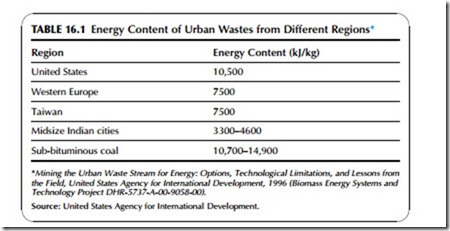WASTE COMPOSITION
The composition of the waste varies from place to place. In general, the waste from the urban household in an industrialized country will contain 30–40% paper and cardboard and up to 10% plastic. The proportions of these in the waste from a household in, for example, the Dominican Republic will be much lower and the Dominican household’s waste will probably contain 80% food waste, whereas the proportion of food in the waste from a U.S. household may only
be 26%.3 More generally, organic waste accounts for more than 60% of waste in low-income countries compared to 25% of the waste stream in richer counties.
There are other important differences. The waste from households in developing countries contains a high proportion of moisture, often as high as 50%, making it difficult to burn without first reducing the moisture content by drying. In contrast, the high proportions of paper and plastic in the waste from a house- hold in the industrial world make it much easier to burn.
All these factors affect the energy content of waste, and energy content is a crucial factor in determining the viability of a power-from-waste plant. Unless the plant can produce enough excess heat from waste combustion to raise steam, then it cannot expect to generate any electricity.
Table 16.1 provides some figures for MSW energy content from different parts of the world. U.S. waste has the highest energy content of those listed. At 10,500 kJ/kg the value is approaching that of sub-bituminous coal. European cities and prosperous Asian cities such as Taipei generate waste with around 7500 kJ/kg. Meanwhile, the waste from typical midsize Indian cities contains roughly half this amount of energy. Some factors affecting the differing energy content are regional, and others are simply a matter of affluence.
In the case of Indian cities, for example, the low energy content may not be due entirely to the quality of waste. In cities in India (but not them alone) much of the urban waste is collected by city sweepers. Such waste is contaminated with considerable quantities of stone, earth, and sand. In Bombay the amount of noncombustible material of this type in waste may reach 30%. Not only does this reduce the energy content of the waste, it could also damage a combustion system, so the design of a waste handling and disposal plant has to take its presence into account.
Given such local variations in waste content it is vitally important, before a power-from-waste plant is built, that the waste available be carefully assessed. For that, local waste collection procedures and organizations have to be examined. The issue will be particularly important for a private sector power-from- waste plant; it is less critical if the project is being built by a local municipality.
